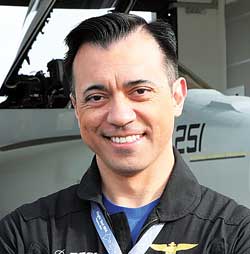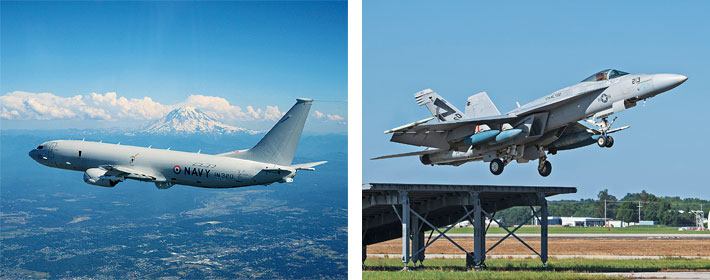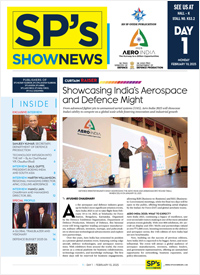- Prime Minister Narendra Modi inaugurates Aero India 2023 in Bengaluru; Releases Commemorative Stamp
- Defence Secretary meets delegations from Saudi Arabia, USA and Oman on the sidelines of Aero India 2023
- Foreign Ministers of 32 countries to attend Aero India 2023
- Embraer showcases the C-390 Millennium at Aero India 2023
Boeing P-8I and F/A-18 Super Hornet Block III: An Effective Tag-team for Maritime Operations in Indo-Pacific
F/A-18s of the Indian Navy can potentially share data with P-8Is of IN as well as P-8s and F/A-18s of the US Navy, and Royal Australian Air Force to improve the capability of partner countries for helping secure the Indo-Pacific.

The Indian Navy continues to shoulder India's increasing strategic and geopolitical responsibility in the Indian Ocean region. The role of naval aviation in defending India's maritime interests is only expected to grow. Mission ready and capable, the Indian Navy's air fleet supports the entire mission spectrum – ranging from countering piracy and asymmetrical warfare to neutralising maritime terrorism. The strength of the partnership for Indo-Pacific will be determined by the abilities of the countries to work together seamlessly. Commonality and interoperability of defence assets contribute not only towards efficient operations of the partner countries but also offer significant enduring strategic benefits to the partners.
P-8I – BOLSTERING LONG RANGE INTELLIGENCE, SURVEILLANCE AND RECONNAISSANCE CAPABILITIES
A formidable part of the Indian Navy's fleet, the P-8 is a proven system with more than 140 aircraft in service that have executed more than 4,00,000 mishap free flight-hours around the globe. Along with the Indian Navy, the P-8 family includes the US Navy, the United Kingdom's Royal Air Force, Royal Australian Air Force and Royal Norwegian Air Force. Militaries that have selected the P-8 include the Royal New Zealand Air Force, Republic of Korea Navy, and German Navy. The P-8's performance and reliability delivers confidence in an uncertain world — in any condition, anywhere, anytime.
The P-8 combines the most advanced weapon system in the world with the cost advantages of the most operated commercial airliner on the planet. The P-8 shares 86 per cent commonality with the commercial 737NG, providing enormous supply chain economies of scale in production and support. Boeing's expertise in commercial fleet management and derivative aircraft sustainment also provides customers with greater availability at a lower operational cost. The P-8 is engineered for 25 years/25,000 hours in the harshest maritime flight regimes, including extended operations in icing environments.
The P-8s Indian variant, referred to as P-8I, is an aircraft designed for long-range anti-submarine warfare (ASW), anti-surface warfare (ASuW), and intelligence, surveillance and reconnaissance (ISR) missions. The P-8 delivers highest levels of quality, reliability, and operability. A true multi-mission aircraft, it is defined by a unique combination of state-of-the-art sensors, proven weapons systems, and a globally recognised platform. Notably, the Indian Navy was the first international customer for the P-8 and today operates the largest non-US fleet. In addition to unmatched maritime reconnaissance and anti-submarine warfare capabilities, the P-8I has been deployed to assist during disaster relief and humanitarian missions.
Since the induction of the P-8I in the Indian Navy, Boeing has been supporting the fleet to ensure high rates of mission readiness. With 12 P-8Is the Indian Navy is rapidly increasing its capability to seal and protect its vast coastline – while also playing a greater role in regional maritime security. The patrol aircraft is an integral part of the Indian Navy's fleet and has surpassed 35,000 flight hours since it was inducted in 2013.
We've been supporting India's growing P-8I fleet by providing performance based logistics, spares, ground support equipment and field service representative and on-site engineering support.

F/A-18 SUPER HORNET BLOCK III – THE WORLD'S MOST ADVANCED, COMBAT PROVEN, MULTI-ROLE FRONTLINE NAVAL FIGHTER
Today, The US Navy operates more than 800 Super Hornets and EA-18 Growlers, the electronic attack version of the F/A-18 and have logged over 2.5 million flight hours on the fleet. The Block III configuration is suited to protect India's maritime interests as it is built to meet the broadest range of missions while benefiting from the upgrades and knowledge related to US naval aviation. We anticipate the Super Hornet opening up opportunities for greater interoperability between the two navies for a more secure Indo-Pacific.
Block III's networking allows the F/A-18 Super Hornet to interface with other assets of the Indian Navy. Recently, there have been tremendous advancements in unmanned systems that are to be used in a naval aviation environment. In the coming days, as Indian Navy inducts such systems, both the single-seat and two seat versions of the Super Hornet on the Indian Navy carrier will allow interfacing with unmanned carrier-borne systems more effectively.
As the F/A-18 Super Hornet has been designed from its inception for carrier operations, over 100 years of US Navy carrier aviation experience and best practices have been incorporated into the design of the aircraft, providing many benefits to the Indian Navy. One of the main benefits of this is that the aircraft has the ability to fold its wings, allowing for better utilisation of deck space on the aircraft carrier. Boeing has conducted thorough study and analysis that optimises the number of Super Hornets that can fit aboard INS Vikramaditya and INS Vikrant, as well as optimises the cyclic operations from those carriers leading to high sortie generation rates. Boeing has also developed a capability specifically for the F/A-18 Super Hornet Block III that will allow for the faster movement of the aircraft between the flight deck and hangar deck without having to remove or modify any part of the aircraft. This capability is compatible with the current elevator/lift configuration aboard Indian aircraft carriers.
Another important fact to note is that the two-seater carrier compatible variant of the Super Hornet offers several unique advantages to the Indian Navy including flexibility, higher utilisation of the fleet, and the ability to embark certain missions from the carrier that benefit from having the second crew member. Additionally, two-seater F/A-18 Super Hornets can be used as trainers (ashore and on the carrier) and as fully capable fighters, operational from carrier and from land bases. Thus, Indian Navy will get tremendous flexibility and a higher asset utilisation rate due to the carrier compatible variant of the two-seater variant of the F/A-18.
The F/A-18 Super Hornet's offer is a perfect confluence of several strategic benefits for the IN. Through the Super Hornet Block III, the Indian Navy will not only get a next-generation naval fighter but will further the collaboration between US Navy and Indian Navy in naval aviation. The commonality and potential interoperability between the navies and air forces of partner countries in the Indo-Pacific will get a boost as a result of the F/A-18 Super Hornet on Indian naval carriers.
We are confident about the long-term growth potential of India's defence sector and are committed to supporting and enabling its progress.





